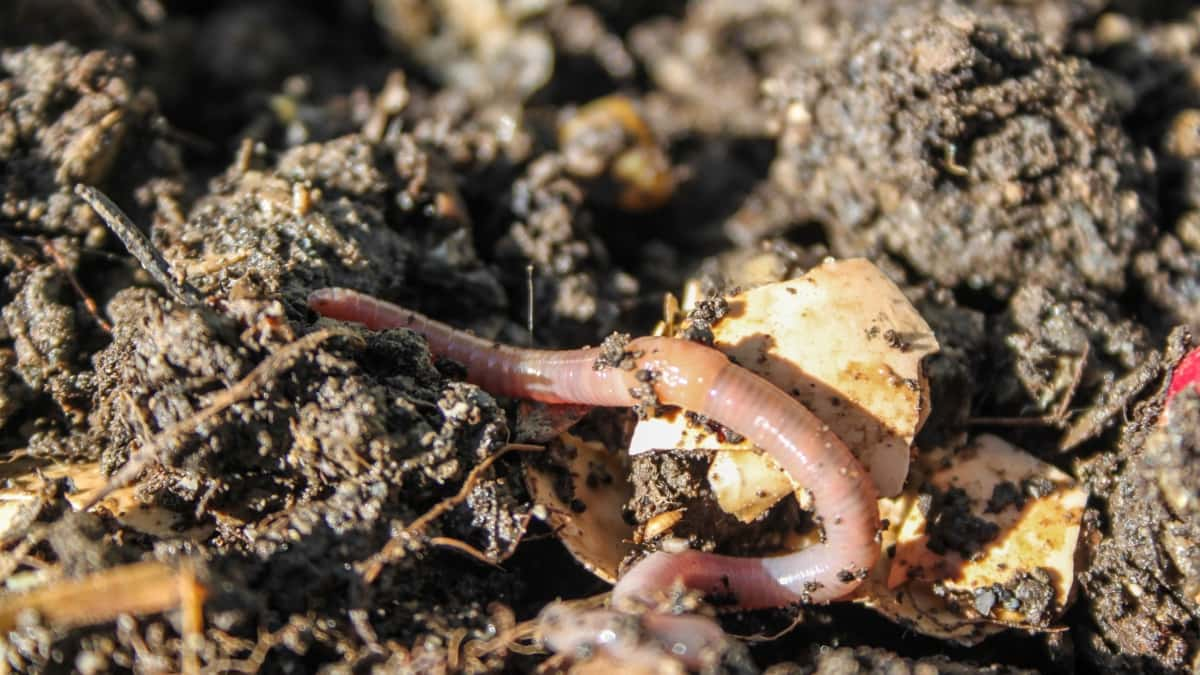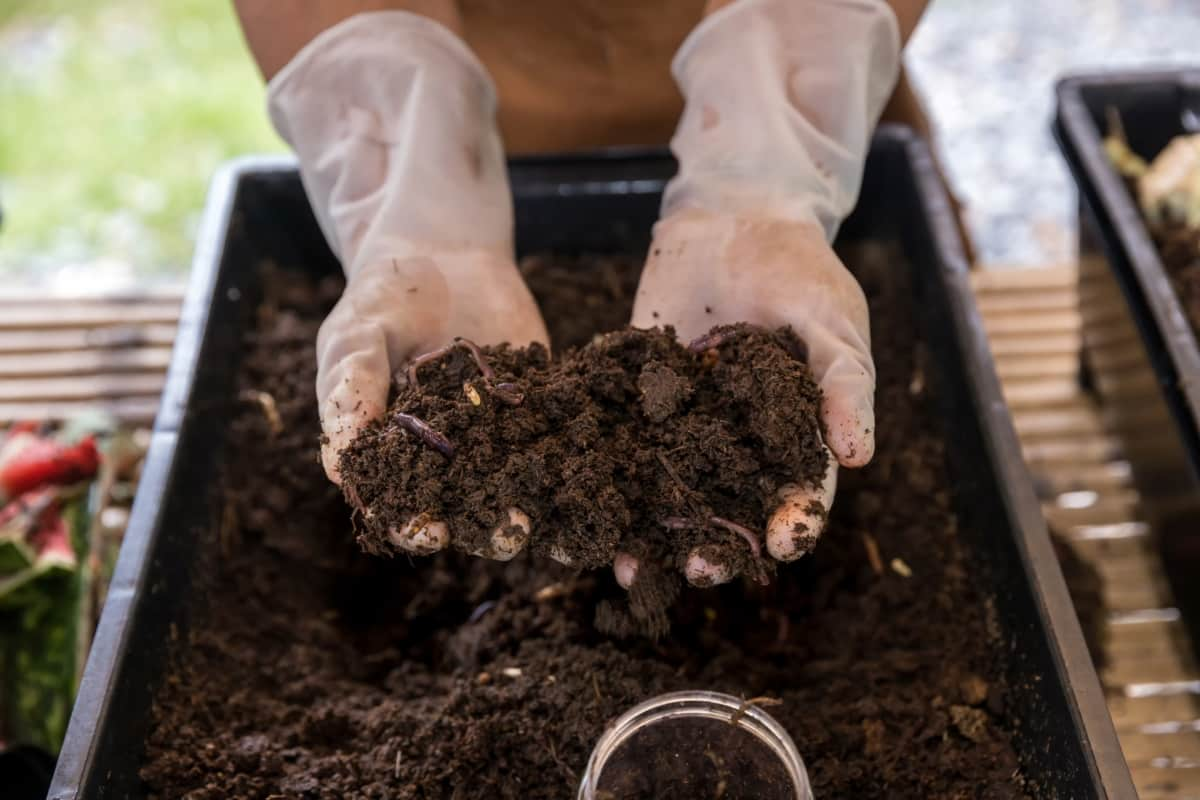Vermicomposting (worm composting) is an interesting project. Your vegetable, flowers, or houseplants will benefit from a nutrient-rich, all-natural fertilizer if everything goes as planned. Worm composting isn’t difficult, but worms escaping from the bins is often challenging for those new to worm farming. The escape of a few worms isn’t a big deal if your bin is brand new, especially if there are only a few worms. However, handling the situation quickly is essential if you are experiencing an exodus of worms.

How to Prevent Worms from Escaping Vermicompost
Maintain Temperature
The temperature range enjoyed by worms and people is similar. Keep your worms healthy and happy by keeping temperatures above 10°C and below 27°C. It is extremely difficult to determine the temperature inside a worm bin without a thermometer during an emergency like a massive worm evacuation. Put your worms in a shady, cooler place when it feels hot. When it feels cold, put them in a warmer place.
Once you have resolved your emergency, consider regularly checking the temperature in your worm bin using one of our worm compost thermometers to ensure the worms are safe and to avoid escaping due to temperature in the future. You can tell whether your worms are comfortable or in danger with the color-coded thermometers.
Maintain pH of the Worm Bin
Your worm bin’s pH (or Power of Hydrogen) measures its acidity. A scale of 0 (acidic) to 14 (basic) measures pH. It is considered neutral when the pH is seven or higher. It is optimal for composting worms to live in a pH between 6 and 7, but they can survive in pH ranges as high as eight or as low as five for short periods.
Consider using a quick and easy smell test instead of a pH meter if you do not have one. There might be a pH imbalance if the worms smell off. Crushed eggshells lower the pH, and grit is added to aid digestion. Potato chips and large amounts of tomatoes are acidic, oily, or salty foods that can lower pH levels.
Maintain Consistent Moisture
Your worms will drown if the bin is too wet. They may make attempts to escape the danger. It also stinks up the bin and is bad for composting. If there is too much mold or mildew, it can grow. Worm bedding should resemble a sponge that has been wrung out. Check the bedding by squeezing it in your hand.
You have a wet bin if water comes out. Wet bins can be cured by adding dry bedding. It is best to use shredded newspaper, coconut coir, peat moss, or cardboard. Stir gently after adding. Keeping the lid on when it rains is especially important to avoid moisture problems. Wet, sloppy foods such as melon or left-over fruit smoothies shouldn’t be added.
Maintain Good Aeration
The worms may also be escaping because they are looking for oxygen. If your worm bin has gone anaerobic, it may also smell foul. An anaerobic bin means there is insufficient oxygen, so odor-producing anaerobic bacteria are breeding inside. Your worm colony’s survival depends on proper oxygen levels, so a bad-smelling bin indicates that action needs to be taken immediately.
In case you missed it: Frequently Asked Questions About Vermicompost

You can resolve anaerobic conditions in your worm bin by turning the bedding gently so that clumps can be broken up and passageways can be made for oxygen to penetrate. Take care not to hurt your worms! After turning your worm bin, leave the lid off for about 30 minutes so the oxygen outside goes directly into your worms’ bedding. When airing out your bin, keep an eye on your worms to ensure they don’t squirm away.
Put Them in a Calm and Dark Environment
Worms are photophobic or light-fearing and will burrow immediately when exposed to light. Once your newly arrived worms are placed in a new environment and have traveled from their old home, they will be restless. Composting bins will not attract them unless a light is left on for 24 to 48 hours.
Their new home should be settled in by then. Set up the bin beforehand with some coconut coir and peat moss to encourage this behavior. Additionally, excessive vibrations may signal danger (from a plow or a mole, for example), so keep your vermicomposter in a peaceful yet easily accessible location.
Maintain Nitrogen Levels
Heat and toxic substances like ammonia are produced by decomposing organic matter. Worms can’t escape these and are driven away from their beds. When using bedding, ensure that it contains only high-carbon (slow-rotting) or high-nitrogen materials that have been thoroughly decomposed.
You should regularly aerate your bedding if you observe that the system is heating up, and add any carbon-rich bedding you need to the system to facilitate heat dissipation. Paper, cardboard, leaf litter (rotten leaves), peat moss, and coco peat-based bedding are some examples of carbon-rich bedding.
Don’t Overfeed
Most newbies make the mistake of overfeeding. There is no hard rule regarding how much your worms should eat daily. They need different amounts of food according to the food type and the conditions of the bin. As a thumb rule, feed less when in doubt. Starving worms is much harder than overfeeding them. Many healthy worms are still in a worm bin if not fed for weeks. However, an overfed bin can quickly become smelly and toxic to the worms, resulting in a crash.
Nonetheless, you shouldn’t stop feeding your worms. Allow your worms to gauge how much food they need. Begin by scraping half a handful of fruit and vegetables. Increase the feeding amount or frequency if the food depletes quickly. Try cutting down the food if much of the previously placed food remains after two feedings. Feed the worms once or twice a week. Frequent feedings will stress both you and the worms. You need a setup that doesn’t require much intervention to be effective.
Don’t Disturb the Worms, if they are Newly Added to Bins
The delivery process can stress out your worms when you first purchase them. There’s no need to panic. They should settle in within 3-5 days. Leave the bin cover off temporarily and store the setup in a well-lit area at night. The worms will usually not escape in large numbers if they do escape. Most people, especially first-timers, believe rummaging through the worms’ bedding will help them. All this does, however, is stress them out. It will benefit the worms if you don’t interfere with the setup too much. Do not overdo checking the worms every few days.
In case you missed it: Neem Rich Vermicompost for Garden Plants: Unlock and Boost the Power of Neem

Conclusion
Learn about your worms, proper worm bin maintenance techniques perfected by experienced worm farmers, and problems that can develop in a worm bin before they arise if you are new to worm composting. Keep an eye on these elements of your worm bin regularly to prevent future problems. Keeping your worm bin clean and well-maintained will preserve your worms’ health and happiness for years.
- Feed Your Flock for Less: Top 10 Tips to Save on Chicken Feed
- Ultimate Guide to Ossabaw Island Hog: Breeding, Raising, Diet, and Care
- Hatching Answers: The Top 10 Reasons Your Chickens Aren’t Laying Eggs
- Eggs and Economics: Breaking Down the Cost of Raising Backyard Chickens
- Defend Your Greens: Proven Methods to Keep Iguanas Out of Your Garden
- Ultimate Guide to Cinnamon Queen Chicken: A Comprehensive Guide for Beginners
- Ultimate Guide to California Tan Chicken: Breeding, Raising, Diet, Egg-Production and Care
- Ultimate Guide to Marsh Daisy Chicken: Breeding, Raising, Diet, and Care
- 10 Types of Chicken Farming Businesses You Can Start for Profits